Week Forty-One: German Breads
Hailing from Hamburg, these spiralled breads are the German cousins of the French croissant — literally. The name “franzbrötchen” translates to “little French breads”, and the parallels are obvious. Both are flaky Viennoiserie, made as they are with dough laminated with butter, and shaped by rolling up the dough into a spiral. However, where the French are perfectly content to let their pastry speak for itself, the Germans prefer to add a bit of spice to theirs, usually cinnamon. Raisins are not an uncommon addition to franzbrötchen; I think all the buried generations of Frenchmen might collectively roll over in their graves if you even approach a croissant with a raisin.
Franzbrötchen, happily, are rather easier to make than are croissants. I recently described the Spanish ensaïmada as a sort of “lazy croissant”; franzbrötchen may be described in the same vein as a “cheater’s croissant”. This is not to say that they aren’t valid in their own right, it’s just that the method is far simpler than with true croissants, and the results are remarkably similar.
Rather than pounding out a giant block of butter, chilling it, folding into dough, chilling, rolling, chilling, rolling, etc., the butter here is simply cut into thin pieces, placed on the dough, folded in, and rolled out minimally. Total chilling time is about 20 minutes, as opposed to about 3 hours for croissants. It’s so easy, and so head-slappingly obvious, it’s no wonder the inventive Germans thought it up.
I’ll be the first to admit that this method won’t produce quite the ethereal creature that is a true croissant, but if your goal is to make a very flaky, buttery, croissant-esque pastry in your own kitchen, you can hardly find an easier way.
These franzbrötchen turn out lightly sweet, spicy and aromatic with the cinnamon, tender layers inside cradled by a crust doubly-crisp: the outermost bits of dough form a paper-thin crust of their own accord, while the sugar filling melts into caramel that coats the exterior with a gossamer crunch.
As an amusing side note, franzbrötchen are so-called throughout Germany, except in the city they originate in, Hamburg. What do you call it there? A Hamburger, of course.
Franzbrötchen
Adapted from spamman.de
Makes 16
For dough:
17½ ounces (4 cups minus 2 tablespoons) unbleached all-purpose flour, plus extra for rolling out dough
1 tablespoon instant yeast
3 tablespoons sugar
1/2 teaspoon salt
1 1/4 cups milk, at room temperature
4 tablespoons (1/2 stick) unsalted butter, melted and cooled slightly
For filling:
12 tablespoons (1½ sticks) unsalted butter, cold
1/2 cup sugar
1 teaspoon cinnamon
1. In the bowl of a stand mixer, whisk together the flour, yeast, sugar, and salt. Add the milk and melted butter. Using the dough hook, mix at low speed for 1 to 2 minutes, or until just combined. Without removing the dough hook, cover the bowl loosely with plastic wrap and let rest for 15 to 20 minutes.
2. Uncover the bowl. Turn the speed to medium-low, and knead for about 5 minutes, or until smooth and elastic. The dough should clear the sides of the bowl and be slightly shiny but not sticky.
3. Transfer the dough into a large, lightly oiled bowl. Cover tightly with plastic wrap, and let sit at room temperature for 1 hour, or until doubled in size.
4. Turn the dough out onto a floured surface, and press to deflate. Using a floured rolling pin, roll the dough out to a rectangle about 12 x 20 inches in size, lifting and stretching at the corners to keep it square.
5. Using a sharp knife, cut the chilled butter into thin slices (see note 1 below), and place evenly over 2/3 of the dough.
Fold the uncovered dough over 1/3 of the butter.
Then fold the remaining 1/3 over the top, making a tri-fold, like folding a letter.
Pinch the edges to seal.
6. Roll the dough out again to 12 x 20 inches, or as big as it will allow, dusting with flour as needed to prevent sticking, lifting and stretching the corners to keep it square.
Tri-fold the dough again.
Wrap the folded dough in plastic wrap loosely but completely, and refrigerate for at least 15 and up to 25 minutes. Lightly grease a large baking sheet or two smaller ones, or line with parchment paper. Preheat the oven to 400º F.
7. Unwrap the dough. Roll out the dough to a rectangle 15 x 30 inches in size, dusting with flour as needed to prevent sticking, lifting and stretching the corners to keep it square. If the dough resists, cover with plastic wrap and let rest 5 to 10 minutes.
8. Brush or spray the dough lightly with water. Mix the sugar and cinnamon together, and sprinkle evenly over the surface of the dough.
Starting with one long edge, roll the dough up tightly, jelly-roll style, into a log.
Pinch the seam to seal the edge.
Turn the log so the seam-side is down.
9. Cut the log into 1 inch wide pieces.
Press the floured handle of a wooden spoon firmly into the top of each piece, all the way down to the counter, so that the spiralled sides flare out on either side of the handle.
Transfer each piece to the prepared baking sheet. Repeat with the remaining pieces.
10. Cover loosely with plastic wrap, and let sit at room temperature for 20 minutes, or until puffy and slightly risen.
11. Bake at 400º F, in the middle of the oven, for 20 to 25 minutes, or until well-browned. Transfer to a wire rack to cool thoroughly.
Notes:
1. I found it easiest to cut the chilled butter first into half-stick lengths, then slice the sticks lengthwise.
2. These turn out rather undersweet (for American palates, that is), which I thought just right. If you prefer a sweeter pastry, feel free to increase the amount of sugar in the dough (to about 1/3 cup) and in the filling (up to 1 cup). Be aware, though, that the more sugar you use in the filling, the more likely it is to run out in baking (read: use rimmed baking sheets).

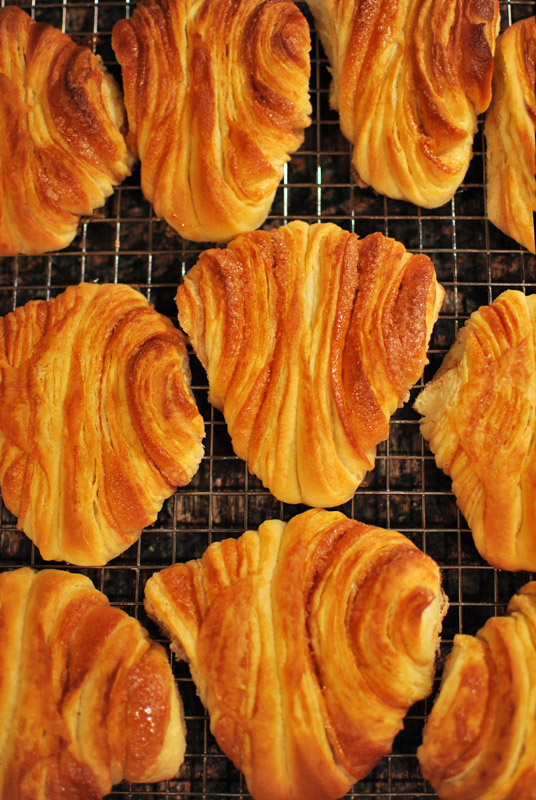
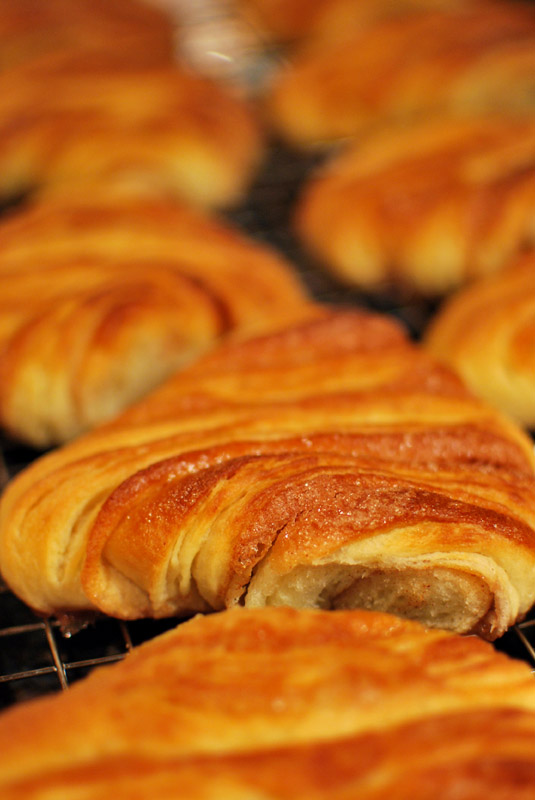
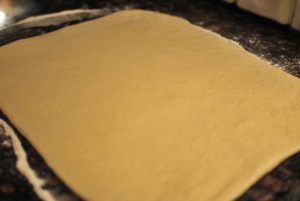

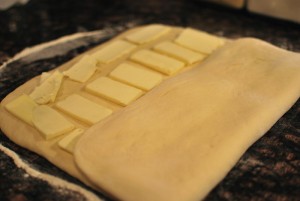
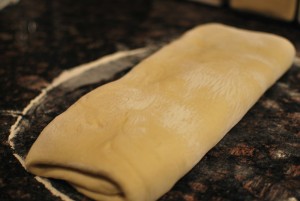

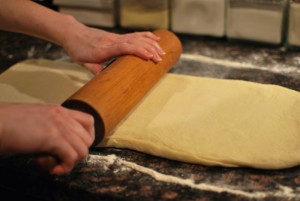

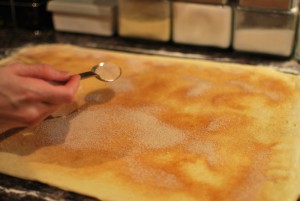


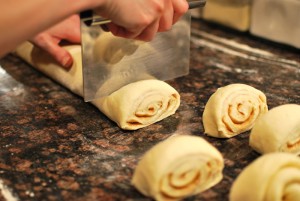
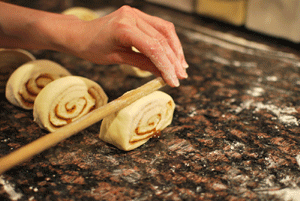
What a pioneer-work! The Franzbrötchen-recipe adapted to english. And thank you for the lovely fotos.
For more (german) information about the Franzbrötchen look at the one an only Franzbrötchen-website: http://www.franzbrötchen.de (www.franzbroetchen.de)
Wolfred
Wolfred: Thanks much for the lovely comment, and from such an authority as yourself! It wasn’t the easiest job in the world, translating this recipe with Google Translator and my one semester of college German, but I was well pleased with the results. You left this comment before I posted the instructional pictures in the recipe; I hope you’ll let me know what you think!
Pingback: Tweets that mention Franzbrötchen « A Bread A Day -- Topsy.com
Wow, what a surprise to find this recipe. I have to make some tomorrow for another fellow expat from Hamburg living in New England. I love your very detailed instructions and pictures, I know that is a lot of work 😉
Just a little note, Franzbrötchen are called ‘Franzbrötchen’ only in Hamburg, in Lübeck they are called ‘Hamburger’ and that is all the extend of their availability, you won’t find them anywhere else.
Happy baking and cooking 🙂
Hi everybody,
nice work, funny to read about “our” pastry in English! Just one detail is not right: In Hamburg, we call this “Franzbrötchen”, in the rest of Germany it doesn’t exist! You can only buy it in and near Hamburg.
Tschüss,
Diana from Hamburg
I bought Franzbrõtchen all over Berlin last year.